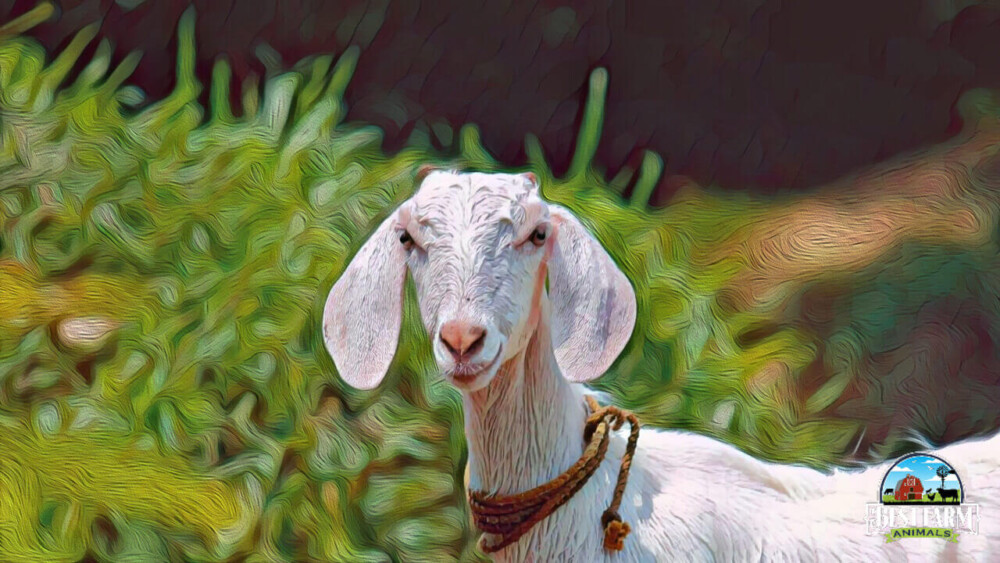Raising goats for either meat or milk can be a rewarding experience, but it’s not without its challenges.
Although goats have a reputation for eating anything and everything, they’re also very active animals that burn many calories. Meeting their nutritional needs can be challenging. A skinny goat will often struggle to regain the weight they’ve lost, so the earlier you try to rectify the problem, the better.

What causes goats to be skinny? Worms are one of the primary reasons for a goat to lose weight, although other diseases and health conditions can also cause weight loss, lethargy, and weakness. Lactating goats need more protein than other herd members and will quickly lose weight if not fed additional forage and grain.
How to Assess Your Goat’s Body Condition
Just looking at a goat tells you little about its body condition and weight.
Many dairy goat breeds, like the Saanen, for example, appear skinny even when they’re in good condition. Dairy goats tend to have distinct hip bones that jut sharply under the skin. Combine that characteristic with their typically barrel bellies and well-defined spine, and even the healthiest dairy goat will look malnourished.
A more reliable way to establish your goat’s condition is through touch.
A Quick Guide to Assessing Your Goat’s Weight

#1 Place your hand on your goat’s back just in front of the hips
#2 Now, put your thumb on one side of the spine and your fingertips on the other
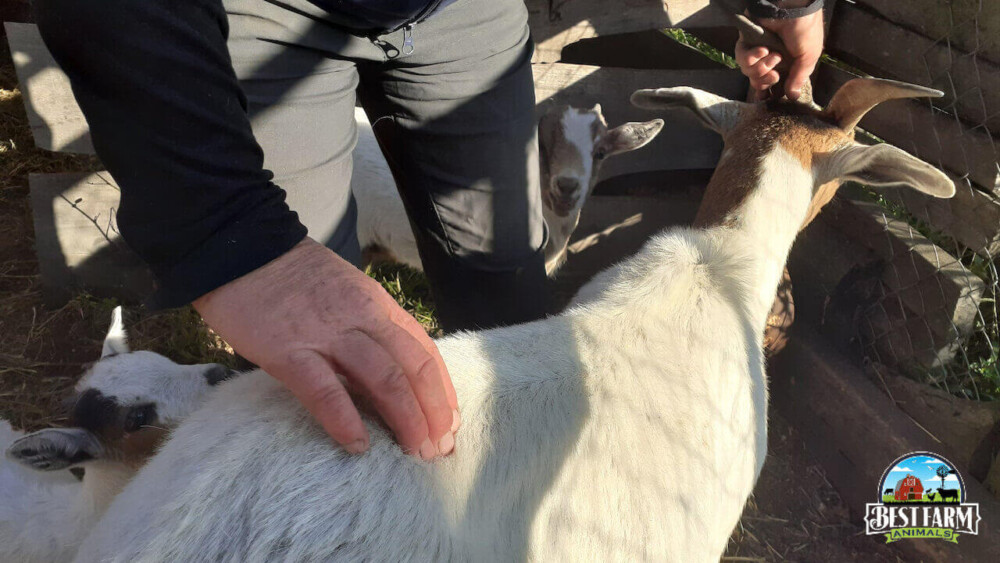
#3 Squeeze your thumb and fingers together, feeling along the spine

If each vertebra is prominent enough that you can feel it through your goat’s skin, then she’s underweight. If you can feel soft, squishy areas on either side of the spine but not the sharp points of the vertebrae, then she’s in good condition.
Like the one pictured below, an overweight goat will have so much padding around the spine that you can’t feel the vertebrae.
While this gives you a fair indication of your goat’s overall health status, knowing what she weighs will help you keep track of her recovery. It also means you can accurately dose her with any medication or supplements she may require.
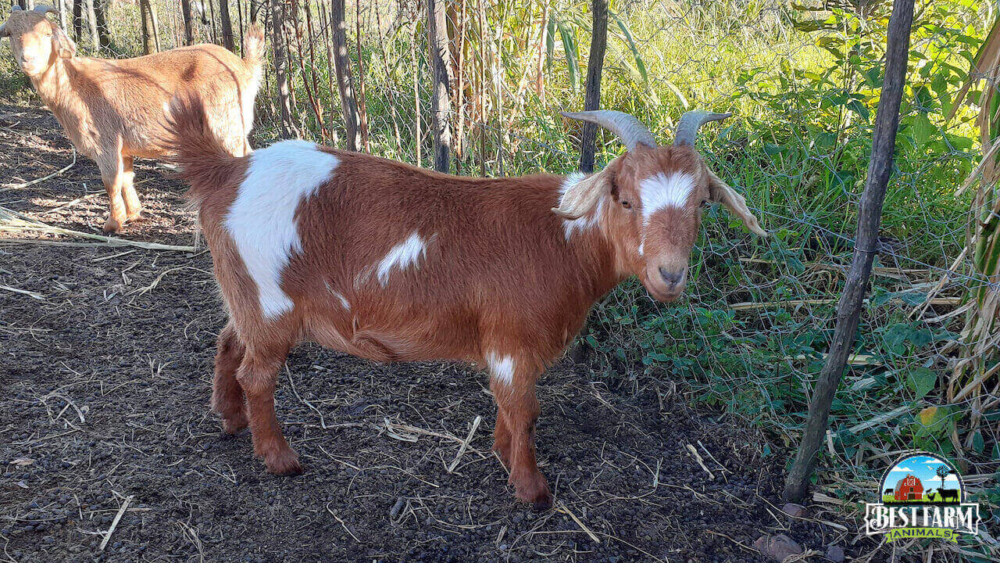
Calculating your Goat’s Weight
The easiest way to calculate your goat’s weight is by using a livestock scale. Unfortunately, these are too expensive for the average homesteader.
The alternative is to measure your goat using a pliable tape measure. To do this, you need two measurements – length and girth.
To measure your goat’s circumference, wrap the tape measure around the goat just behind the withers. Record this measurement before moving on to the length. Measure your goat from the point of the shoulder to the pin bone, as illustrated in the image below.

Using these measurements, perform the following calculation:
(Heart girth x Heart girth x Length) / 300 = Weight (lbs)
Remember that this weight calculation may not be 100% accurate, especially for meat goats.
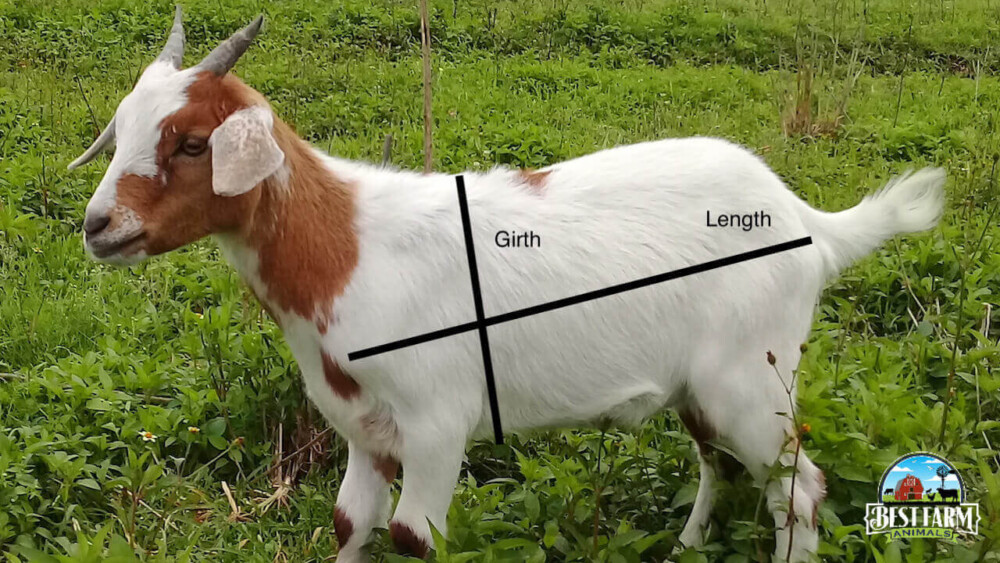
Health Problems that Cause Weight Loss in Goats
Before trying to manage your skinny goat’s weight, you must first rule out any diseases and other health conditions that might be causing the problem. Two common problems that cause weight loss are worms and other internal parasites and copper deficiency.
How can you tell if your goat has worms? The quickest way to assess your goat’s parasitic burden is to pull out the lower eyelid and check its color. Worms cause anemia in goats, so a goat with a worm infestation will have a yellow or white eyelid. A healthy goat’s eyelid will be either a rich salmon color or bright pink. A fecal count will also tell you if your goat has a heavy parasite load.
How do you know if your goat has copper deficiency? A goat with a copper deficiency will lose weight and its coat will fade and become rough to the touch. Other symptoms include anemia and diarrhea.
Other health conditions that can cause weight loss in goats include:
Johne’s disease – a potentially fatal gastrointestinal disease that causes rapid weight loss and diarrhea
Scrapie – a potentially fatal, degenerative disease that affects the central nervous system causing progressive weight loss
Tuberculosis – is a respiratory condition that causes weight loss, lethargy, and loss of appetite. This article contains more information on tuberculosis in goats and how to treat it.
Caprine arthritis encephalitis – a virus causing arthritis, pneumonia, mastitis, and weight loss
Caseous Lymphadenitis – is a chronic and contagious bacterial disease that affects the lymph nodes, causing swelling, coughing, and weight loss.
A 6-Step Approach to Managing a Skinny Goat
Once you’ve treated the underlying health condition, use this six-step management regime to help your goat regain its weight and strength as quickly as possible. First, make sure you are feeding your goats enough food. Goats will typically eat most of the day. If your goat is out of food for most of their waking hours, they probably don’t have enough hay. Assuming your goat gets to eat hay most of the day, there are additional steps you can take to help it increase its weight.
#1 Increase your Goat’s Weight by Feeding Grain
Feeding your goat grain is the quickest way to get it to gain weight. Grains are high in carbohydrates and, therefore, calorie-dense.
Oats and corn are two of the best grains for weight gain.
Although corn’s not very high in protein or fat, it’s high in carbohydrates and packed with fiber, vitamins, and minerals. On the downside, it increases your goat’s body temperature, so it is only suitable for weight gain during winter.
Oats are high in protein and fiber and will quickly boost your goat’s weight gain and growth.
From an energy point of view, studies indicate that corn is a better feed than oats, with one pound of corn replacing 1.9 lb of forage, compared to 1.6 lb for oats.
Alternatively, you could opt for a commercial grain mix, like Purina Goat Grower, which contains a good nutritional balance of proteins, minerals, and vitamins.
According to experts like Susan Schoenian, a retired sheep and goat specialist at the University of Maryland Extension, you should never feed your goat more than 1.5 lb of grain a day to avoid overfeeding.
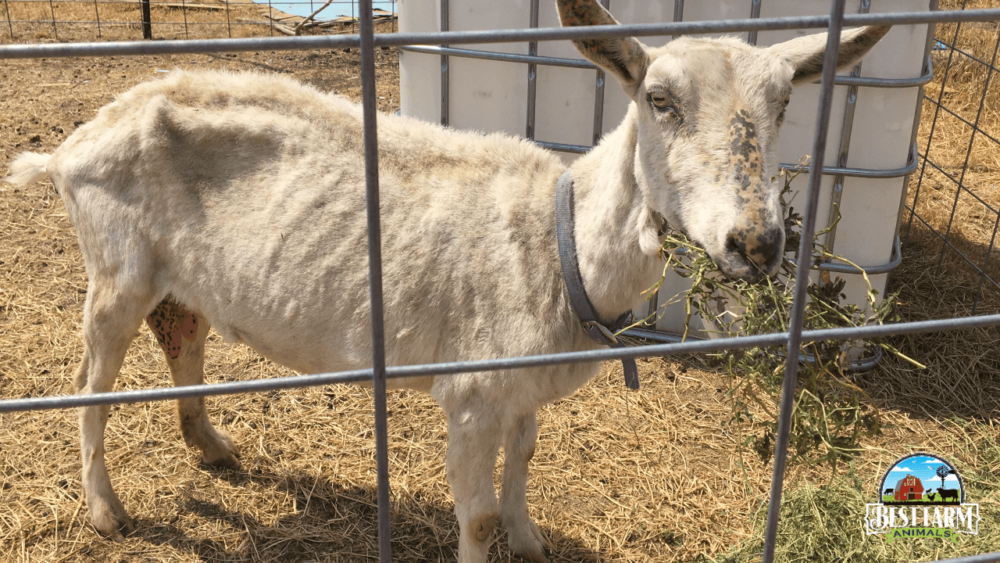
#2 A Skinny Goat needs high-quality forage
Alfalfa is the best forage for a skinny goat. It’s high in protein and contains more energy, calcium, and other minerals and vitamins than other types of hay.
My goats aren’t always that keen on eating alfalfa, especially if the bale contains a lot of stalks. Only high-quality, leafy alfalfa appeals to them, which can be tricky to find. Second crop alfalfa is the best for this. If you can’t get your hands on good-quality alfalfa, opt for Bermuda or Timothy grass instead. Although neither has the equivalent protein content, they are both rich in fiber and contain reasonable quantities of nutrients.
#3 6 Supplements that will Help a Skinny Goat Gain Weight
Goats need six supplements to maintain or regain condition:
- Calcium – boosts enzyme activity, stimulating the appetite and improving food conversion efficiency.
- Copper – boosts the immune system
- Iodine – regulates the rate of metabolism
- Iron – reduces the anemia associated with parasites
- Manganese – increases energy and growth rate
- Selenium – improves thyroid function and boosts the immune system
- Sodium – encourages healthy appetite and weight gain
- Zinc – reduces stress, and improves immune response and enzyme activity
The best goat supplements, like the Purina Goat Mineral Supplement, provide the correct balance of all these components and other essential vitamins.
#4 Skinny Goats Benefit from Higher Protein Intake
Mature goats need a daily intake of crude protein of 7%, while goats that are pregnant, lactating, or still growing need slightly more.
Feeding a high-quality forage, like alfalfa, will provide adult goats with adequate amounts of dietary protein. For those that need to gain weight or are recovering from an illness, protein supplements are advisable.
Many farmers use soybean meal to increase their goat’s protein intake. Not only is soybean high in protein, but it’s also high in energy and fiber. Other high-protein foodstuffs include barley, peas, corn, oats, canola, and cottonseed.
Studies also suggest that a high-protein diet helps control internal nematode parasites by increasing your goat’s resistance and resilience.
#5 Grazing is Essential for Underweight Goats
The more time your goat can spend browsing and grazing naturally, the healthier its digestive system will be. Grazing is also the cheapest way to get a skinny goat to gain weight.
Of course, if your goat has lost its appetite, sending it out into a field of lush grass isn’t going to improve its condition.
A skinny but otherwise healthy goat will quickly select the most nutritious plants available, gaining weight naturally as it samples leaves, flowers, fruits, and stems.
#6 Goats Need Access to Fresh Water to Gain Weight
As a rule, goats don’t drink much water, primarily because they get most of what they need from foraging. A goat’s water requirements vary depending on its stage of production. A lactating doe, for example, requires a lot of water, while a young goat will drink more during warm weather than it will when the forage is wet.
Goats will lose weight during the dry season because they don’t get enough to drink and, without sufficient water in their systems, they can’t digest efficiently.
Streams and rivers provide the best water sources for goats, but a trough will suffice if these aren’t available.

5 Ways to Stimulate your Goat’s Appetite
#1 Electrolytes can Encourage a Skinny Goat to Eat
Electrolytes replenish lost fluids and accelerate the absorption of critical nutrients and energy. It helps a skinny goat regain its natural fluid balance, regurgitating and digest its food more effectively, thereby increasing appetite.
While there are good-quality goat electrolytes available, like this one from Manna Pro, you can also make your own using the following recipe:
Ingredients for goat electrolytes:
- 2 tsp baking soda
- 2 tsp salt
- 1/2 cup molasses or raw honey
- 4 quarts of warm water
Method
Combine the ingredients until all the powders dissolve. Use a drenching syringe to administer the electrolytes every 2 hours for 12 hours, or until you’ve used all the solution.
#2 Molasses can Help Stimulate your Goat’s Appetite
Small grain meals flavored with molasses are more appealing than dry grains. Mix half a pound of your chosen grain with a tablespoon of molasses
#3 Fermented Grains are Easier to Digest
A goat that’s lost its appetite will find fermented grains easier to digest than dry ones. They also increase fluid levels and provide a natural probiotic to stimulate the digestive system.
Grains need to be submerged in water for at least 24 hours to ferment. The grain must then be drained and rinsed before feeding.
#3 Dark Beer Restarts the Rumen
Horse trainers swear by the medicinal properties of dark beers like Guinness and stout. These beers contain water, barley, yeast, and hops, which appear to “restart the rumen,” stimulating the appetite.
#4 Fresh, Green Forage can Help your Goat Regain its Appetite
Our goats are fussy eaters, but few of them can resist a handful of clover or other fresh leaves. Not only can these stimulate a goat’s appetite, but they also provide a good source of essential vitamins.
#5 Separate a Skinny Goat at Feeding Time
An undernourished goat may take longer to eat than healthy animals, so the only way to ensure it gets the necessary nutrients is to separate it from the herd at feeding time. Isolating your skinny goat also allows you to feed it smaller meals more frequently.

My Essential Goat Supplies
This list contains affiliate products. Affiliate products do not cost more but helps to support BestFarmAnimals and our goal to provide farm animal owners with accurate and helpful information.
This little giant bucket fits on a fence and this one’s easy to carry.
A sturdy dog collar is essential. Don’t do rope (they’ll break and tangle) or chain (injury!).
A Black Water Tub is way nicer than buckets that tip over. I like to get a 20 or 30-gallon in each pen so my goats have plenty of water, but you can get 100-gallons if you have a lot of sheep in one pen.
Loose minerals in a small bag or a Purina 50 lb bag, and a mineral feeder for free-choice is the best option. One side holds minerals, and the other holds baking soda. Don’t feed sheep goat minerals because it usually contains copper- something that is fatal to sheep.
Hoof trimmers are a necessity because you’ll need to trim your sheep’s hooves every few months. These are nice for the price.
Don’t make the mistake I made by waiting to order a drench gun before you need it. I was surprised by how often I use it. It helps with bloating, dehydration, and other ailments. Here’s a good drench, but you can also drench a bloat solution or water if dehydrated.
Digital Thermometor for when your lambs act sick. You’ll need to know if their temps are too low or too high so you can accurately diagnose the issues.
Vetericyn for wound care. It makes a big difference in a speedy recovery.
Check out this list of goat milk supplies you need if you have milk goats.
Conclusion
A skinny goat has little or no fat covering its spine. Before helping your goat gain weight, you first must treat any underlying health conditions, such as copper deficiency or worms.
Once your goat’s health is stable, you can use the six-step plan detailed above to help it gain weight. You can also monitor its recovery by keeping track of its weight using a livestock scale or tape measure.
Underweight goats can recover relatively quickly if they receive the necessary protein, fiber, and nutrients they need to restore them to their former glory. Water is also essential if the goat is to digest its food effectively.
A skinny goat isn’t life-threatening as long as you take proper steps to determine what your goat needs and how you can help it put some weight back on in a healthy way.

